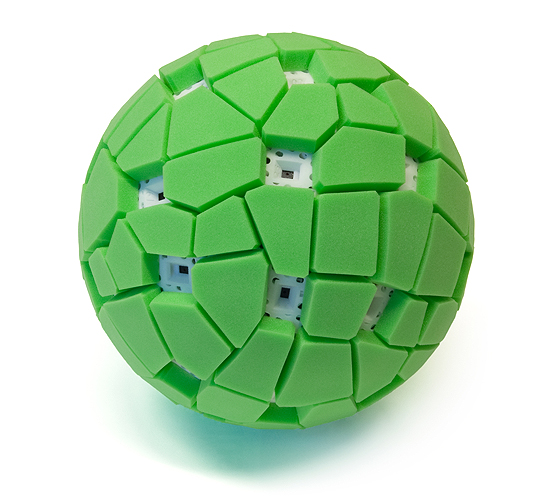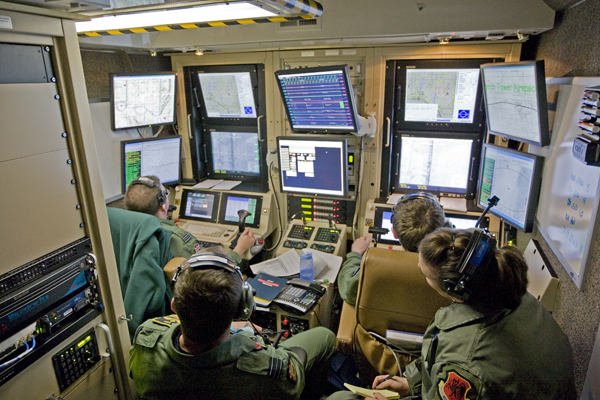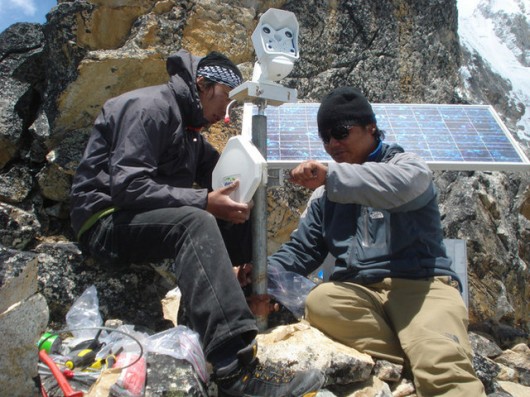Entries tagged as hardware
Related tags
3d camera flash game headset history mobile mobile phone software technology tracking virtual reality web wiki www 3d printing 3d scanner crowd-sourcing diy evolution facial copy food innovation&society medecin microsoft physical computing piracy programming rapid prototyping recycling robot virus ad android ai algorythm apple arduino automation data mining data visualisation network neural network sensors siri amd cpu intel qualcomm app google htc ios linux os sdk super collider tablet usb api facial recognition glass interface mirror amazon cloud iphone ar augmented reality satellite army drone artificial intelligence big data car cloud computing privacy program super computer asus kinect light wifi chrome browser firefox ie laptop computing farm open source security sustainabilityWednesday, November 23. 2011
Kilobots - tiny, collaborative robots - are leaving the nest
Via PhysOrg
-----
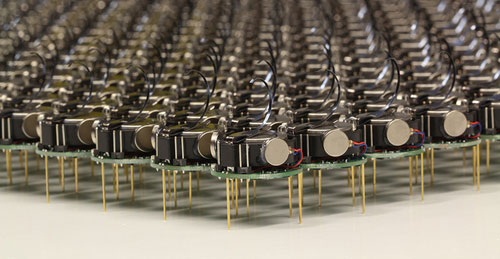
The Kilobots are an inexpensive system for testing synchronized and collaborative behavior in a very large swarm of robots. Photo courtesy of Michael Rubenstein
The Kilobots are coming. Computer scientists and engineers at Harvard University have developed and licensed technology that will make it easy to test collective algorithms on hundreds, or even thousands, of tiny robots.
Called Kilobots, the quarter-sized bug-like devices scuttle around on three toothpick-like legs, interacting and coordinating their own behavior as a team. A June 2011 Harvard Technical Report demonstrated a collective of 25 machines implementing swarming behaviors such as foraging, formation control, and synchronization.
Once up and running, the machines are fully autonomous, meaning there is no need for a human to control their actions.
The communicative critters were created by members of the Self-Organizing Systems Research Group led by Radhika Nagpal, the Thomas D. Cabot Associate Professor of Computer Science at the Harvard School of Engineering and Applied Sciences (SEAS) and a Core Faculty Member at the Wyss Institute for Biologically Inspired Engineering at Harvard. Her team also includes Michael Rubenstein, a postdoctoral fellow at SEAS; and Christian Ahler, a fellow of SEAS and the Wyss Institute.
Thanks to a technology licensing deal with the K-Team Corporation, a Swiss manufacturer of high-quality mobile robots, researchers and robotics enthusiasts alike can now take command of their own swarm.
One key to achieving high-value applications for multi-robot systems in the future is the development of sophisticated algorithms that can coordinate the actions of tens to thousands of robots.
"The Kilobot will provide researchers with an important new tool for understanding how to design and build large, distributed, functional systems," says Michael Mitzenmacher, Area Dean for Computer Science at SEAS.
"Plus," he adds, "tiny robots are really cool!"
The name "Kilobot" does not refer to anything nefarious; rather, it describes the researchers' goal of quickly and inexpensively creating a collective of a thousand bots.
Inspired by nature, such swarms resemble social insects, such as ants and bees, that can efficiently search for and find food sources in large, complex environments, collectively transport large objects, and coordinate the building of nests and other structures.
Due to reasons of time, cost, and simplicity, the algorithms being developed today in research labs are only validated in computer simulation or using a few dozen robots at most.
In contrast, the design by Nagpal's team allows a single user to easily oversee the operation of a large Kilobot collective, including programming, powering on, and charging all robots, all of which would be difficult (if not impossible) using existing robotic systems.
So, what can you do with a thousand tiny little bots?
Robot swarms might one day tunnel through rubble to find survivors, monitor the environment and remove contaminants, and self-assemble to form support structures in collapsed buildings.
They could also be deployed to autonomously perform construction in dangerous environments, to assist with pollination of crops, or to conduct search and rescue operations.
For now, the Kilobots are designed to provide scientists with a physical testbed for advancing the understanding of collective behavior and realizing its potential to deliver solutions for a wide range of challenges.
-----
Personal comment:
This remembers me one project I have worked on, back in 2007, called "Variable Environment", which was involving swarm based robots called "e-puck" developed at EPFL. E-pucks were reacting in an autonomous manner to human activity around them.
Tuesday, November 22. 2011
Electronic contact lens displays pixels on the eyes
-----
(Image: Institute of Physics)
The future of augmented-reality technology is here - as long as you're a rabbit. Bioengineers have placed the first contact lenses containing electronic displays into the eyes of rabbits as a first step on the way to proving they are safe for humans. The bunnies suffered no ill effects, the researchers say.
The first version may only have one pixel, but higher resolution lens displays - like those seen in Terminator - could one day be used as satnav enhancers showing you directional arrows for example, or flash up texts and emails - perhaps even video. In the shorter term, the breakthrough also means people suffering from conditions like diabetes and glaucoma may find they have a novel way to monitor their conditions.
In February, New Scientist revealed the litany of research projects underway in the field of contact lens enhancement. While one company has fielded a contact lens technology using a surface-mounted strain gauge to assess glaucoma risk, none have built in a display, or the lenses needed for focused projection onto the retina - and then tested it in vivo. They have now.
"We have demonstrated the operation of a contact lens display powered by a remote radiofrequency transmitter in free space and on a live rabbit," says a US and Finnish team led by Babak Praviz of the University of Washington in Seattle.
"This verifies that antennas, radio chips, control circuitry, and micrometre-scale light sources can be integrated into a contact lens and operated on live eyes."
The test lens was powered remotely using a 5-millimetre-long antenna printed on the lens to receive gigahertz-range radio-frequency energy from a transmitter placed ten centimetres from the rabbit's eye. To focus the light on the rabbit's retina, the contact lens itself was fabricated as a Fresnel lens - in which a series of concentric annular sections is used to generate the ultrashort focal length needed.
They found their lens LED glowed brightly up to a metre away from the radio source in free space, but needed to be 2 centimetres away when the lens was placed in a rabbit's eye and the wireless reception was affected by body fluids. All the 40-minute-long tests on live rabbits were performed under general anaesthetic and showed that the display worked well - and fluroescence tests showed no damage or abrasions to the rabbit's eyes after the lenses were removed.
While making a higher resolution display is next on their agenda, there are uses for this small one, say the researchers: "A display with a single controllable pixel could be used in gaming, training, or giving warnings to the hearing impaired."
"This is clearly way off in the future. But we're aware of the research that is ongoing in this field and we're watching the technology's potential for biosensing and drug delivery applications in particular," says a spokesperson for the British Contact Lens Association in London.
Monday, November 21. 2011
Cotton Candy Device Puts Small Android-Powered Computer In A Thumb Drive
Via nexus404
-----
The rush to make computers smaller and smaller has been going on for some time now, but we may have a winner–at least for now–in terms of the small computer race. It’s called the Cotton Candy from FXI Tech, and though it just looks like your standard USB thumb drive, it turns out it’s packing an entire very small computer in its tiny packaging.
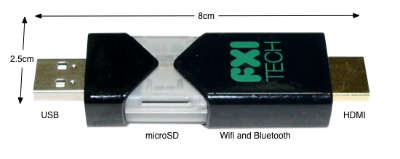
The specs, admittedly, aren’t anything truly spectacular, offering up a dual-core ARM Cortex A9 on the processor end, backed up by an ARM Mali-400MP GPU, wi-fi and Bluetooth connectivity, a USB plug and a microSD card slot as well as its own Android operating system. But when you consider that it’s all encased in a device that’s the size of a basic key chain, well, suddenly the whole picture looks a lot more interesting.
What this is designed to do is hook into much larger displays, thanks to that HDMI plug, and allow you to perform many of your basic computer functions. You’ve got Bluetooth for the peripherals, microSD for the storage, cloud access from the Android app…it’s a very simple, very basic, but extremely portable setup. And, you can even hook it into another computer with the USB plug included, which in turn will let you borrow the peripherals hooked into that computer (great if you needed to print something, I’d say) to do the various jobs you want done.
And if you want an ultra-small computer to take with you most anywhere you go, Cotton Candy should be on hand in time for Christmas 2012, and the pricing is expected to land at the $200 mark, which isn’t half bad. Though it does make me wonder why most wouldn’t just buy a full on laptop for not too much more, especially if they buy used.
Still though, an ultra-small PC for an ultra-small price tag is in the offing, so what do you guys think? Will the Cotton Candy catch on? Or will we be seeing these go for half that or less just to clear them out? No matter what you think, we love hearing from you, so head on down to the comments section and tell us what you think!
Wednesday, November 09. 2011
NVIDIA Tegra 3 quad-core mobile processor revealed and detailed
Via Slash Gear
By Chris Burns
-----
The next generation of mobile processors has arrived in the form of the NIVIDA Tegra 3, formerly known as Project Kal-El, a quad-core chipset with aspirations to dominate the Android landscape in 2012 as theTegra 2 dual-core processor dominated the majority of 2011. Though many of the details have already been revealed by NVIDIA before today on how Tegra 3 functions and is able to bring you the consumer more power, less battery consumption, and more effective workload distribution, this marks both the official naming of the chip as well as the official distribution of easy to process videos on how Tegra 3 will affect the average mobile device user.
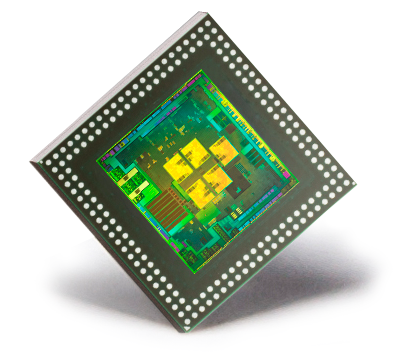
NVIDIA’s Tegra 3 chipset has been gone over in full detail by your humble narrator in two posts here on SlashGear just a few weeks ago in two posts, one on how there are actually [five cores, not just four], and another all about [Variable Symmetric Multiprocessing] aka vSMP. Note that back then NVIDIA had not yet revealed that the final market name for the processor would be “Tegra 3? at the time these posts were published, instead still using the codename “Project Kal-El” to identify the chipset. The most important thing you should take away from these posts is this: your battery life will be better and the distribution of power needed by your processor cores will be handled more intelligently.
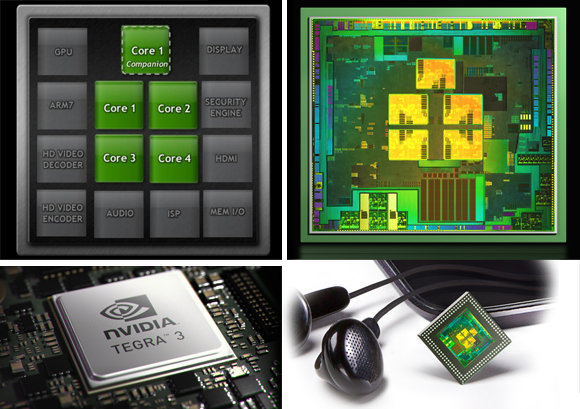
NVIDIA has provided a few videos that will explain again in some rather easy to process detail what we’re dealing with here in the Tegra 3. The first of these videos shows visually what cores use which amount of power as several different tasks are performed. Watch as a high-powered game uses all four cores while browsing a webpage might only use a single core. This is the power of Variable Symmetric Multiprocessing in action.
NVIDIA Tegra 3: Fifth Companion Core
Next there’s a demonstration of an upcoming game that would never have been able to exist on a mobile platform if it hadn’t been for NVIDIA’s new chip architecture and the power of a quad-core chipset – along with NVIDIA’s twelve GPU cores of course. We had a look at this game back earlier this year in the first Glowball post – now we go underwater:
Glowball Video 2: Tegra 3 goes underwater
Finally there’s a lovely set of videos showing you exactly what it means for game developers and gamers to be working with the Tegra 3 chipset. The first video shows off how next-generation games are being made specifically for this chipset, developers working hand in hand with NVIDIA to optimize their games for the Tegra 3 so that gamers can get the most awesome experience in mobile history. Devour this, if you will:
NVIDIA Tegra 3: Developers bring Next-Generation Games to Mobile
You can also see several examples of the games in the video and how they’ve been improved in the Tegra 3 world. Riptide GP as well as Shadowgun have been reviewed and given hands-on videos by your humble narrator in the past – can’t wait for the enhanced visions! Next have a look at these games running side-by-side with their original versions. Make sure you’re sitting down, because you’re going to get pumped up.
Side-by-side Gameplay Competition vs Tegra 3
Down to the frames per second, this new chipset will change the world you live in as far as gaming goes. Of course it doesn’t stop there, but in that gaming is one of the best ways to test a processor on this platform, one made with gaming in mind of course, you’ve got to appreciate the power. Have a peek at this tiny chart to see what we mean:
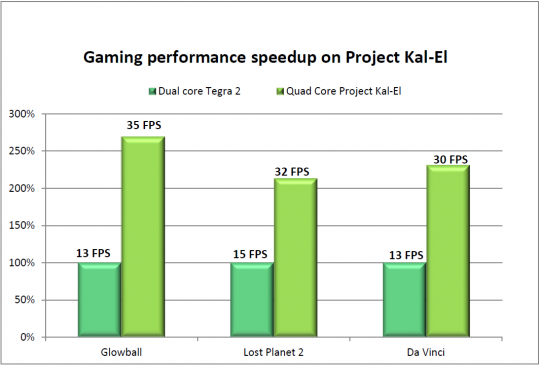
Then head over to the post from ASUS on what the very first hardware running the Tegra 3 will look like. It’s the ASUS Eee Pad Transformer Prime, a 10.1-inch tablet from the makers of the original Transformer, a device made to pummel the competition and usher in a whole new age in mobile computing. We look forward to the future, NVIDIA, bring on another year of complete and total annihilation of the competition!
Monday, November 07. 2011
Introducing the 5-watt server that runs on cell phone chips
Via giagom
-----
Can ARM wrestle its way into the server market? Calxeda and Hewlett-Packard think so. On Tuesday Calxeda launched its EnergyCore ARM server-on-a-chip (SoC), which it says consumes as little as 1.5 watts (and idles at half a watt). And HP, the world’s largest server maker, committed to building EnergyCore-based servers that will consume as little as 5 watts when running all out. Compare that to the lowest-power x86 server chips from Intel, which consume about 20 watts but deliver higher performance.
Calxeda, backed in part by ARM Holdings, is banking that the success that ARM chips found in smartphones and mobile devices will carry over into data centers serving large, scale-out workloads. In that arena, it is facing off squarely against chip giant Intel and its x86-based architecture, which dominates the market for chips running in commodity servers.
Said Calxeda in a statement:
Thanks to its mobile phone heritage and patent-pending innovations from Calxeda, the new processor consumes less than one tenth the power of today’s most energy-efficient server processors and is ideal for workloads such as web serving, ‘Big Data’ applications, scalable analytics such as Apache Hadoop, media streaming and mid-tier infrastructure such as caching and in-memory databases.
EnergyCore targets web serving, big data apps
The small form factor and energy stinginess of EnergyCore, based on the ARM Cortex processor, suits an emerging and fast-growing class of web and cloud applications, but it lacks in terms of software support and currently won’t support the enterprise demand for 64-bit processors. Thus, for traditional data centers locked into the Intel x86 architecture and with lots of legacy software to run, Calxeda might be a stretch. But that might not matter.
“For big cloud companies that buy gargantuan numbers of servers and for whom the power and space issues get linearly nasty as they build up the number of nodes, this is a good solution,” said analyst Roger Kay, the founder and president of Endpoint Technologies Associates.
These sorts of transactions take on an almost consultative nature, where the server vendor works with the customer’s developers, he said.
EnergyCore is 32-bit only, a fact that Intel will no doubt trumpet. “High-performance computing [HPC] needs 64 bits to deal with larger address space, but that doesn’t mean that 32-bit [processors] can’t address certain data center applications,” Kay said. “This new chip is designed to handle very large databases that in turn handle lots of queries from many end points. Think Google Earth where there are lots of simple queries — ‘show me the bits in the X-Y grid specified.’”
HP estimates that those big scale-out web and cloud data center scenarios represent a healthy 10 to 15 percent of the data center market, Kay noted. That’s certainly worth fighting for. Intel pegs that segment at 10 percent of the overall market.
 Richard
Fichera, the VP and an analyst at Forrester Research, said Calxeda did
its homework. “This looks to be at least three to five times more energy
efficient than other chips and [energy use] is a growing concern for
data centers.” Some of what Calxeda has done will be hard for
competitors to replicate, he said.
Richard
Fichera, the VP and an analyst at Forrester Research, said Calxeda did
its homework. “This looks to be at least three to five times more energy
efficient than other chips and [energy use] is a growing concern for
data centers.” Some of what Calxeda has done will be hard for
competitors to replicate, he said.
Calxeda, like SeaMicro, which makes low-power servers running Intel Atom processors, also builds on a fabric that lets all the various SoC components communicate inside the box.
Skeptics point out that big data center buyers tend to be a conservative lot, not likely to gamble on a new chip architecture. “Many CIOs will go with the devil they know. They have software that runs on Intel so why move?” Kay said. But again, Calxeda and HP are seeking out the biggest of the big data center companies — those that have a lot of in-house development talent that are not as bound by legacy software concerns.
What’s in EnergyCore SoC?
- Multicore ARM Cortex processor running at 1.1 GHz to 1.4 GHz
- Supports FPU (scalar) and NEON (SIMD) Floating Point
- 4 MB of onboard shared L2 cache
- Integrated Memory Controller with 72-bit datapath, and ECC
- Typical maximum power consumption (running 100% CPU load under normal conditions) is 5 watts
- Typical idle power consumption is less than .5 watts
Calxeda and HP will start rolling out sample products later this year, with volume ramping up in 2012. Calxeda is not alone in this arena: Marvell Inc. is already in the market with its own ARM-based servers. NVIDIA is also building an ARM-based server, dubbed Denver, for HPC.
While Calxeda is tiny compared to Intel, it also doesn’t manufacture its own silicon, which could end up hurting it when comparing it to Intel, one of the last silicon vendors to own its own chip manufacturing. Fichera notes that Calxeda has no control over the distribution and sales of what it designs: The server partner has all the leverage. If someone else has a better SoC next year, Calxeda (or whatever SoC provider they use) could be gone.
Tuesday, November 01. 2011
Multi-Device Web Design: An Evolution
Via LUKEW
By Luke Wroblewski
-----
As mobile devices have continued to evolve and spread, so has the process of designing and developing Web sites and services that work across a diverse range of devices. From responsive Web design to future friendly thinking, here's how I've seen things evolve over the past year and a half.
If you haven't been keeping up with all the detailed conversations about multi-device Web design, I hope this overview and set of resources can quickly bring you up to speed. I'm only covering the last 18 months because it has been a very exciting time with lots of new ideas and voices. Prior to these developments, most multi-device Web design problems were solved with device detection and many still are. But the introduction of Responsive Web Design really stirred things up.
Responsive Web Design
Responsive Web Design is a combination of fluid grids and images with media queries to change layout based on the size of a device viewport. It uses feature detection (mostly on the client) to determine available screen capabilities and adapt accordingly. RWD is most useful for layout but some have extended it to interactive elements as well (although this often requires Javascript).
Responsive Web Design allows you to use a single URL structure for a site, thereby removing the need for separate mobile, tablet, desktop, etc. sites.
For a short overview read Ethan Marcotte's original article. For the full story read Ethan Marcotte's book. For a deeper dive into the philosophy behind RWD, read over Jeremy Keith's supporting arguments. To see a lot of responsive layout examples, browse around the mediaqueri.es site.
Challenges
Responsive Web Design isn't a silver bullet for mobile Web experiences. Not only does client-side adaptation require a careful approach, but it can also be difficult to optimize source order, media, third-party widgets, URL structure, and application design within a RWD solution.
Jason Grigsby has written up many of the reasons RWD doesn't instantly provide a mobile solution especially for images. I've documented (with concrete) examples why we opted for separate mobile and desktop templates in my last startup -a technique that's also employed by many Web companies like Facebook, Twitter, Google, etc. In short, separation tends to give greater ability to optimize specifically for mobile.
Mobile First Responsive Design
Mobile First Responsive Design takes Responsive Web Design and flips the process around to address some of the media query challenges outlined above. Instead of starting with a desktop site, you start with the mobile site and then progressively enhance to devices with larger screens.
The Yiibu team was one of the first to apply this approach and wrote about how they did it. Jason Grigsby has put together an overview and analysis of where Mobile First Responsive Design is being applied. Brad Frost has a more high-level write-up of the approach. For a more in-depth technical discussion, check out the thread about mobile-first media queries on the HMTL5 boilerplate project.
Techniques
Many folks are working through the challenges of designing Web sites for multiple devices. This includes detailed overviews of how to set up Mobile First Responsive Design markup, style sheet, and Javascript solutions.
Ethan Marcotte has shared what it takes for teams of developers and designers to collaborate on a responsive workflow based on lessons learned on the Boston Globe redesign. Scott Jehl outlined what Javascript is doing (PDF) behind the scenes of the Globe redesign (hint: a lot!).
Stephanie Rieger assembled a detailed overview (PDF) of a real-world mobile first responsive design solution for hundreds of devices. Stephan Hay put together a pragmatic overview of designing with media queries.
Media adaptation remains a big challenge for cross-device design. In particular, images, videos, data tables, fonts, and many other "widgets" need special care. Jason Grigsby has written up the situation with images and compiled many approaches for making images responsive. A number of solutions have also emerged for handling things like videos and data tables.
Server Side Components
Combining Mobile First Responsive Design with server side component (not full page) optimization is a way to extend client-side only solutions. With this technique, a single set of page templates define an entire Web site for all devices but key components within that site have device-class specific implementations that are rendered server side. Done right, this technique can deliver the best of both worlds without the challenges that can hamper each.
I've put together an overview of how a Responsive Design + Server Side Components structure can work with concrete examples. Bryan Rieger has outlined an extensive set of thoughts on server-side adaption techniques and Lyza Gardner has a complete overview of how all these techniques can work together. After analyzing many client-side solutions to dynamic images, Jason Grigsby outlined why using a server-side solution is probably the most future friendly.
Future Thinking
If all the considerations above seem like a lot to take in to create a Web site, they are. We are in a period of transition and still figuring things out. So expect to be learning and iterating a lot. That's both exciting and daunting.
It also prepares you for what's ahead. We've just begun to see the onset of cheap networked devices of every shape and size. The zombie apocalypse of devices is coming. And while we can't know exactly what the future will bring, we can strive to design and develop in a future-friendly way so we are better prepared for what's next.
Resources
I referenced lots of great multi-device Web design resources above. Here they are in one list. Read them in order and rock the future Web!
- Effective Design for Multiple Screen Sizesby Bryan Rieger
- Responsive Web Design (article) by Ethan Marcotte
- Responsive Web Design (book) by Ethan Marcotte
- There Is No Mobile Web by Jeremy Keith
- mediaqueri.es by various artisits
- CSS Media Query for Mobile is Fool’s Gold by Jason Grigsby
- Why Separate Mobile & Desktop Web Pages? by Luke Wroblewski
- About this site... by Yiibu
- Where are the Mobile First Responsive Web Designs? by Jason Grigsby
- Mobile-First Responsive Web Design by Brad Frost
- Mobile-first Media Queries by various artists
- The Responsive Designer’s Workflow by Ethan Marcotte
- Responsible & Responsive (PDF) by Scott Jehl
- Pragmatic Responsive Design (further details) by Stephanie Rieger
- A Closer Look at Media Queries by Stephen Hay
- Responsive IMGs — Part 1 by Jason Grigsby
- Responsive IMGs — Part 2 by Jason Grigsby
- Device detection as the future friendly img option by Jason Grigsby
- Responsive Video Embeds with FitVids by Dave Rupert
- Responsive Data Tables by Chris Coyier
- RESS: Responsive Design + Server Side Components by Luke Wroblewski
- Adaptation (PDF) by Bryan Rieger
- How I Learned to Stop Worrying and Set my Mobile Web Sites Free by Lyza Danger Gardner
- The Coming Zombie Apocalypse by Scott Jenson
- Future Friendly by various artists
Tuesday, October 18. 2011
Throwable Panoramic Ball Camera captures any moment in 3D
Jonas Pfeil, a recent graduate of the Technical University of Berlin, created the Throwable Panoramic Ball Camera as a way to instantly create panoramic images without the often tedious digital stitching process common today. Equipped with an accelerometer, when thrown the camera creates full spherical panoramas that display three-dimensional images of a moment captured in time. Although the device is not yet for sale, it will be on display at the upcoming Siggraph Asia conference. You can see the ball's technology at work in the video below.
Thursday, October 13. 2011
Nettop Round-Up: Four Tiny PCs, Benchmarked And Reviewed
Via Tom's Hardware
-----
We're testing four nettops: Arctic Cooling’s MC001-BD, ASRock’s CoreHT 252B, Giada’s i50, and Zotac’s Zbox AD03BR-PLUS. All of these tiny, quiet systems take a very different approach to compact computing, and we fill you in on what makes them unique.
Intel’s Atom CPU might have been the driving force behind the popularization of the nettop form factor, but manufacturers are squeezing more powerful hardware into these tiny machines. Sometimes, more potent graphics performance is added via a mobile chipset. Sometimes, processing m muscle is emphasized instead with a CPU designed for powerful notebook. And now, APUs belonging to AMD's Fusion initiative are an option, serving up efficient power use and higher-performance graphics on a single processor die.
Truly, the nettop is no longer a stripped-down machine barely capable of Web browsing and word processing. These tiny PCs are tailor-made to excel in specific applications, which often includes use in a home theater.

Click here to get the full survey
Saturday, October 08. 2011
Computer Virus Hits U.S. Drone Fleet
Photo courtesy of Bryan William Jones
A computer virus has infected the cockpits of America’s Predator and Reaper drones, logging pilots’ every keystroke as they remotely fly missions over Afghanistan and other warzones.
The virus, first detected nearly two weeks ago by the military’s Host-Based Security System, has not prevented pilots at Creech Air Force Base in Nevada from flying their missions overseas. Nor have there been any confirmed incidents of classified information being lost or sent to an outside source. But the virus has resisted multiple efforts to remove it from Creech’s computers, network security specialists say. And the infection underscores the ongoing security risks in what has become the U.S. military’s most important weapons system.
“We keep wiping it off, and it keeps coming back,” says a source familiar with the network infection, one of three that told Danger Room about the virus. “We think it’s benign. But we just don’t know.”
Military network security specialists aren’t sure whether the virus and its so-called “keylogger” payload were introduced intentionally or by accident; it may be a common piece of malware that just happened to make its way into these sensitive networks. The specialists don’t know exactly how far the virus has spread. But they’re sure that the infection has hit both classified and unclassified machines at Creech. That raises the possibility, at least, that secret data may have been captured by the keylogger, and then transmitted over the public internet to someone outside the military chain of command.
Drones have become America’s tool of choice in both its conventional and shadow wars, allowing U.S. forces to attack targets and spy on its foes without risking American lives. Since President Obama assumed office, a fleet of approximately 30 CIA-directed drones have hit targets in Pakistan more than 230 times; all told, these drones have killed more than 2,000 suspected militants and civilians, according to the Washington Post. More than 150 additional Predator and Reaper drones, under U.S. Air Force control, watch over the fighting in Afghanistan and Iraq. American military drones struck 92 times in Libya between mid-April and late August. And late last month, an American drone killed top terrorist Anwar al-Awlaki — part of an escalating unmanned air assault in the Horn of Africa and southern Arabian peninsula.
But despite their widespread use, the drone systems are known to have security flaws. Many Reapers and Predators don’t encrypt the video they transmit to American troops on the ground. In the summer of 2009, U.S. forces discovered “days and days and hours and hours” of the drone footage on the laptops of Iraqi insurgents. A $26 piece of software allowed the militants to capture the video.
The lion’s share of U.S. drone missions are flown by Air Force pilots stationed at Creech, a tiny outpost in the barren Nevada desert, 20 miles north of a state prison and adjacent to a one-story casino. In a nondescript building, down a largely unmarked hallway, is a series of rooms, each with a rack of servers and a “ground control station,” or GCS. There, a drone pilot and a sensor operator sit in their flight suits in front of a series of screens. In the pilot’s hand is the joystick, guiding the drone as it soars above Afghanistan, Iraq, or some other battlefield.
Some of the GCSs are classified secret, and used for conventional warzone surveillance duty. The GCSs handling more exotic operations are top secret. None of the remote cockpits are supposed to be connected to the public internet. Which means they are supposed to be largely immune to viruses and other network security threats.
But time and time again, the so-called “air gaps” between classified and public networks have been bridged, largely through the use of discs and removable drives. In late 2008, for example, the drives helped introduce the agent.btz worm to hundreds of thousands of Defense Department computers. The Pentagon is still disinfecting machines, three years later.
Use of the drives is now severely restricted throughout the military. But the base at Creech was one of the exceptions, until the virus hit. Predator and Reaper crews use removable hard drives to load map updates and transport mission videos from one computer to another. The virus is believed to have spread through these removable drives. Drone units at other Air Force bases worldwide have now been ordered to stop their use.
In the meantime, technicians at Creech are trying to get the virus off the GCS machines. It has not been easy. At first, they followed removal instructions posted on the website of the Kaspersky security firm. “But the virus kept coming back,” a source familiar with the infection says. Eventually, the technicians had to use a software tool called BCWipe to completely erase the GCS’ internal hard drives. “That meant rebuilding them from scratch” — a time-consuming effort.
The Air Force declined to comment directly on the virus. “We generally do not discuss specific vulnerabilities, threats, or responses to our computer networks, since that helps people looking to exploit or attack our systems to refine their approach,” says Lt. Col. Tadd Sholtis, a spokesman for Air Combat Command, which oversees the drones and all other Air Force tactical aircraft. “We invest a lot in protecting and monitoring our systems to counter threats and ensure security, which includes a comprehensive response to viruses, worms, and other malware we discover.”
However, insiders say that senior officers at Creech are being briefed daily on the virus.
“It’s getting a lot of attention,” the source says. “But no one’s panicking. Yet.”
Friday, September 30. 2011
Researchers install world’s highest webcam to provide a view of Everest
Via gizmag
-----
After starting out producing security cameras, German-based Mobotix is now taking video surveillance to new heights - literally. One of the company's type-M12 cameras has been situated at an altitude of 5,643-meters (18,514 ft) on the Kala Patthar mountain to stream high definition images of the summit of the nearby 8,848-meter (29,029 ft) high Mount Everest. The solar-powered webcam takes the title of the world's highest webcam from the now second highest webcam in the world located at the 4,389-meter (14,400 ft) high base camp of Mount Aconcagua in Argentina.
The Kala Patthar location, which was chosen for its excellent view of the western side of Everest, including the north and southwest faces of the mountain and the West Ridge, exposes the webcam to some pretty harsh conditions with high winds and temperatures as low as -30°C (-22°F). Images captured by the webcam are transmitted wirelessly to the Ev-K2-CNR Pyramid Laboratory/Observatory, which is located at an altitude of 5,050 meters (16,568 ft). Here, the video is analyzed before being sent onto Italy for further evaluation.
"We spent months developing the perfect setup for the installation and invested a lot of time testing and verifying the system. And it inspired us on to set a record: operating the highest webcam in the world," said Giampietro Kohl, leader of the Ev-K2-CNR technical committee who coordinated the webcam's installation by Italian engineers and the Nepalese Ev-K2-CNR team as part of the "Everest Share 2011" research project,
The research project is taking place as part of the international "Share" climate and environmental monitoring conference, with researchers hoping the images, in conjunction with meteorological data gathered at the world's highest weather station sitting at an altitude of 8,000 meters (26,247 ft) on Mount Everest, will provide an insight into climate change.
People can take in the view provided by the Mobotix webcam from the comfort of their homes by pointing their browsers here. The webcam is only active during the daylight hours of 6:00 a.m. to 6:00 p.m. Nepalese time, with images updated every five minutes to allow the researchers to track the movement of the clouds around the mountain summit. If you'd like to turn the view around and see what it looks like from the summit of Everest, there's also a nice 360-degree panorama here.
Quicksearch
Popular Entries
- The great Ars Android interface shootout (130700)
- Norton cyber crime study offers striking revenue loss statistics (100989)
- MeCam $49 flying camera concept follows you around, streams video to your phone (99708)
- Norton cyber crime study offers striking revenue loss statistics (57218)
- The PC inside your phone: A guide to the system-on-a-chip (56998)
Categories
Show tagged entries
Syndicate This Blog
Calendar
|
|
December '25 | |||||
| Mon | Tue | Wed | Thu | Fri | Sat | Sun |
| 1 | 2 | 3 | 4 | 5 | 6 | 7 |
| 8 | 9 | 10 | 11 | 12 | 13 | 14 |
| 15 | 16 | 17 | 18 | 19 | 20 | 21 |
| 22 | 23 | 24 | 25 | 26 | 27 | 28 |
| 29 | 30 | 31 | ||||



